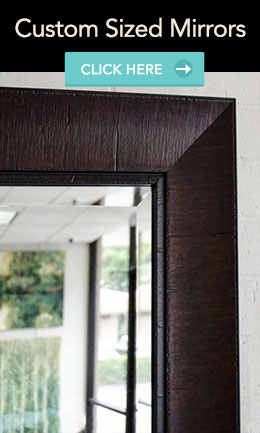
High-quality vs Low-quality Mirrors
Mirrors play an important role in enhancing space, light, and aesthetics in interior design. But, not all mirrors are created equal. For interior designers, remodeling companies, and home design professionals, understanding the nuances between high-quality and low-quality mirrors is essential. Learn how to determine mirror quality to ensure your projects achieve both functionality and elegance.
1. Glass Purity and Clarity
The foundation of a superior mirror lies in the quality of its glass. High-quality mirrors use low-iron glass, which offers exceptional clarity and minimal color distortion. In contrast, standard glass contains higher iron content, resulting in a greenish tint that can alter the true colors of reflected objects. For spaces where color accuracy is important, such as retail stores or art galleries, choosing a low-iron glass ensures a true-to-life reflection.
2. Optimal Thickness
Mirror thickness significantly impacts durability and reflection quality. A thickness of at least ¼ inch (6 mm) is recommended for high-quality mirrors, as it provides structural integrity and minimizes distortion. Thinner mirrors are more susceptible to warping over time, leading to distorted reflections that can detract from the overall design.
3. Surface Flatness and Distortion
A flat mirror surface is crucial for accurate reflections. To assess flatness, place a straight object, like a ruler, against the mirror’s surface. If gaps or distortions are visible, the mirror may have imperfections. High-quality mirrors maintain a uniform surface, ensuring that reflections are true and undistorted.
4. Silvering Quality
Silvering refers to the reflective coating applied to the back of the glass. High-quality mirrors feature a thick, evenly applied silver coating, often protected by additional layers to prevent tarnishing and corrosion. This ensures longevity and consistent reflectivity. Low-quality mirrors may have thin or uneven silvering, leading to dark spots and reduced reflectivity over time.
5. Protective Backing Materials
The backing material of a mirror contributes to its durability and resistance to environmental factors. High-quality mirrors typically use sturdy materials like wood or aluminum for backing, providing structural support and protection against moisture. Low-quality mirrors may use flimsy materials like cardboard, which can be damaged quickly, especially in humid environments.
6. Edge Treatment and Safety
Properly treated edges not only enhance the aesthetic appeal of mirrors but also improve safety. High-quality mirrors often feature polished or beveled edges, reducing the risk of injury and preventing chipping. This attention to detail reflects the overall craftsmanship and quality of the mirror.
7. Compliance with Industry Standards
Reputable mirror manufacturers adhere to industry standards, such as the ASTM C1503 specification, which outlines the requirements for silvered flat glass mirrors. Compliance with these standards ensures that the mirror meets specific criteria for quality, durability, and performance.
Selecting high-quality mirrors shouldn’t be an afterthought. You should pay close attention to factors like glass purity, thickness, surface flatness, silvering, backing materials, edge treatment, and industry compliance. These features will help design professionals choose their mirrors that enhance both the functionality and aesthetic appeal of their projects. Investing in superior mirrors not only elevates the overall design but also ensures longevity and client satisfaction.


